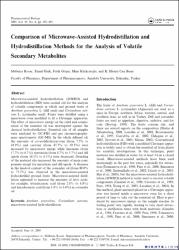Comparison of microwave-assisted hydrodistillation and hydrodistillation methods for the analysis of volatile secondary metabolites
Özet
Microwave-assisted hydrodistillation (MWHD) and hydrodistillation (HD) were carried out for the analysis of volatile components in Whole and ground fruits of Anethum graveolens L. (dill seed) and Coriandrum sativum L. (coriander seed). Fruits were distilled using a microwave oven modified to fit a Clevenger apparatus. The effect of microwave energy on the yield and composition of the essential oil was investigated against the classical hydrodistillation. Essential oils of all samples were analyzed by GC-FID and gas chromatography-mass spectrometry (GC-MS). In the whole dillseed oil, the amounts of cis-isodihyorocarvone (from 7.5% to 10.9%) and carvone (from 45.7% to 69.3%) were increased by microwave energy while limonene (from 17.7% to 4.7%), myristicin (from 8.7% to 5.7%) and dill apiole (from 14.1% to 6.1%) were decreased. Grinding of the material also increased the amounts of main components except for myristicin and dill apiole. A decrease in the linalool content of the coriander oil (from 80.0% to 75.5%) was observed in the microwave-assisted hydrodistilled ground fruits. Microwave-assisted distillation appeared to increase the amounts of fatty acids, for example, tetradecanoic acid (from 2.8% to 8.8%) and hexadecanoic acid (from 1.9% to 6.0%) in coriander oil.
Kaynak
Pharmaceutical BiologyCilt
43Sayı
6Koleksiyonlar
- Makale Koleksiyonu [488]
- Scopus İndeksli Yayınlar Koleksiyonu [8325]
- WoS İndeksli Yayınlar Koleksiyonu [7605]


















